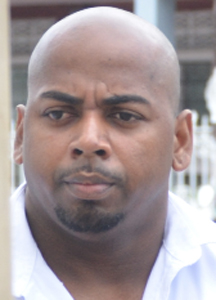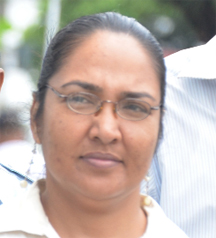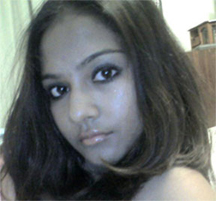Constable Leon George yesterday continued his testimony regarding photographs he took at the Emerald Tower resort, Madewini crime scene where 16-year-old Neesa Gopaul’s body was discovered stuffed in a suitcase in the creek.
Bibi Sharima-Gopaul, the teen’s mother and her stepfather Jarvis Small, are on trial for her murder before Justice Navindra Singh in the High Court.
The jointly-charged duo stands accused of killing the teenager between September 24, 2010, and October 2, 2010, at Madewini, Linden-Soesdyke Highway.
During the hearing, which commenced at 9.45 am and lasted for about two hours, George identified the 25 photos, as well as the negatives admitted into evidence, which he confirmed as being those he took at the crime scene.
The court heard that among the things photographed, were a passport belonging to Neesa, as well as the remains of a female.
As the photos were being circulated for members of the jury, the defence and the judge to view, the young girl’s mother was moved to tears as she momentarily tightly squeezed an asthma inhaler in her hand.



Tears steadily rolled down the woman’s cheek during the greater part of the hearing. At various points during the trial, she sat in a bent position with her hands and head on her lap.
She appeared visibly distressed, gently rocking back and forth in the prisoners’ dock, where she sat inches away from her calm co-accused, who was expressionless.
George testified about visiting the crime scene on two separate occasions to take photographs. He admitted under cross-examination by defence attorney Glenn Hanoman, that a few of the exposures were damaged.
On this issue, Hanoman had initially asked the witness whether some of the photographs were spoilt, but State Counsel Diana Kaulesar successfully objected to that line of questioning on the grounds that no such photos had been entered into evidence.
The court heard from the witness that he took photos from the entrance of Emerald Tower all the way into the resort at the crime scene.
Hanoman peppered him with numerous questions and his response to many was either, “I can’t recall,” or “I won’t be able to say.”
Quizzed by Hanoman about the number, or even an estimation of the number of photos he took at the crime scene, George said he could not recall.
He also could not estimate how long he spent at the scene on his two visits and his response was the same when asked about how long the journey is from Georgetown to Emerald Tower.
It was at this point that Hanoman rhetorically asked George whether he regarded the matter as a high-profile one.
The witness testified to not seeing any dumbbells/weights at the crime scene on his first visit, but answered in the affirmative when asked by counsel if on his second visit to the scene he was going with the intentions of taking photos of weights.
The lawyer then asked it if were possible that someone had placed the dumbbells at the scene by the second visit. The witness however said that he would not be able to say.
George was then asked if it was Corporal Laundry who had told him that weights were at the scene. This question was, however, not answered as Justice Singh upheld the prosecution’s objection that it would amount to “hearsay.”
Hanoman was, however, allowed to ask George whether he had asked Laundry who had given him the information regarding the weights. The witness was not permitted to answer what Laundry may have related to him, based on what the source would have said to Laundry regarding the weights as this too would have amounted to hearsay.
George, however, he did not ask Laundry about his source.
Questioned whether he assisted Laundry in the processing of the scene, and in what way, the witness told Hanoman, “I assisted Laundry by holding his hand.”
“That sounds very romantic,” Hanoman quipped, asking if by that he meant that he was anchoring him close to the shore as he retrieved the suitcase in which Neesa’s remains were found. George said yes.
Counsel then asked George whether he inspected the buildings and surroundings for blood and items, such as clothing. He said no.
Hanoman’s final enquiry sought to determine from the witness whether in retrospect he would now say it might have been wise to check those buildings. “I won’t be able to say,” George calmly responded.
George was then grilled by Sharima-Gopaul’s attorney, George Thomas, who also questioned him about various scenes captured in the photographs.
Thomas also asked George about the back of one of the photos, which seemed to have writing over something else that was initially written.
Under re-examination, however, when asked the reason for the over-writing, George told the prosecutor, “My pen was giving me a lil problem.”
George concluded his testimony when the morning’s proceedings ended at 11:55 after the foreman indicated to Justice Singh that the jury had no questions.
The judge reminded the jurors not to discuss the case with anyone nor among themselves and ordered them to return to court on Monday at 9 am when the trial continues.
George, is attached to the Criminal Investigation Department’s crime lab at Police Headquarters.
Small is represented by a team of four lawyers: Hanoman, Bernard De Santos SC, Lyndon Amsterdam and Zanna Frank.
The body of the teen, a former Queen’s College student, had been stuffed into a suitcase, which was discovered by a group of picnickers on October 2, 2010. The suitcase had been anchored in the creek at the Emerald Tower Resort with several dumbbells. Her head had been bashed in so that her remains appeared headless.
A woman who made the discovery said that a large piece of metal was removed from the creek by the police the following day.
The case provoked widespread public outrage and condemnation of those who failed to assist the teenager during a difficult period of abuse in varying forms prior to her death.





